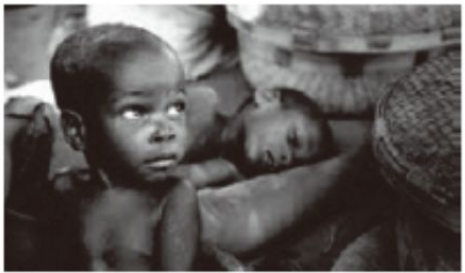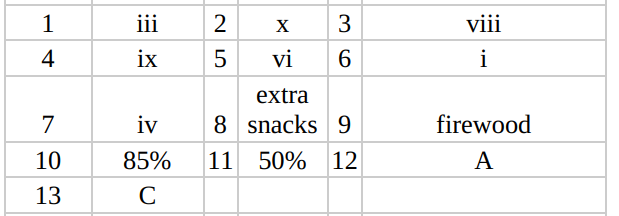Table of Contents
Passage

A. There are not enough classrooms at the Msekeni primary school, so half the lessons take place in the shade of yellow-blossomed acacia trees. Given this shortage, it might seem odd that one of the school’s purpose-built classrooms has been emptied of pupils and turned into a storeroom for sacks of grain. But it makes sense. Food matters more than shelter.
B. Msekeni is in one of the poorer parts of Malawi, a landlocked southern African country of exceptional beauty and great poverty. No war lays waste Malawi, nor is the land unusually crowded or infertile, but Malawians still have trouble finding enough to eat. Half of the children under five are underfed to the point of stunting. Hunger blights most aspects of Malawian life, so the country is as good a place as any to investigate how nutrition affects development, and vice versa.

C. The headmaster at Msekeni, Bernard Kumanda, has strong views on the subject. He thinks food is a priceless teaching aid. Since 1999, his pupils have received free school lunches. Donors such as the World Food Programme (WFP) provide the food: those sacks of grain (mostly mixed maize and soyabean flour, enriched with vitamin A) in that converted classroom. Local volunteers do the cooking—turning the dry ingredients into a bland but nutritious slop, and spooning it out on to plastic plates. The children line up in large crowds, cheerfully singing a song called “We are getting porridge”.
D. When the school’s feeding programme was introduced, enrolment at Msekeni doubled. Some of the new pupils had switched from nearby schools that did not give out free porridge, but most were children whose families had previously kept them at home to work. These families were so pool that the long-term benefits of education seemed unattractive when set against the short-term gain of sending children out to gather firewood or help in the fields. One plate of porridge a day completely altered the calculation A child fed at school will not howl so plaintively for food at home. Girls, who are more likely than boys to be kept out of school, are given extra snacks to take home.
E. When a school takes in a horde of extra students from the poorest homes, you would expect standards to drop. Anywhere in the world, poor kids tend to perform worse than their better-off classmates. When the influx of new pupils is not accompanied by any increase in the number of teachers, as was the case at Msekeni, you would expect standards to fall even further. But they have not Pass rates at Msekenl improved dramatically, from 30% to 65%.
Although this was an exceptional example, the nationwide results of school feeding programmes were still pretty good. On average, after a Malawian school started handing out free food it attracted 38% more girls and 24% more boys. The pass rate for boys stayed about die same, while for girls it improved by 93%.

F. Better nutrition makes for brighter children. Most immediately, well-fed children find it easier to concentrate. It is hard to focus the mind on long division when your stomach is screaming for food. Mr Kumanda says that it used to be easy to spot the kids who were really undernourished. “They were the ones who stared into space and didn?t respond when you asked them questions,” he says.
More crucially, though, more and better food helps brains grow and develop. Like any other organ in the body, the brain needs nutrition and exercise. But if it is starved of the necessary calories, proteins and micronutrients. It Is stunted, perhaps not as severely as a muscle would be, but stunted nonetheless. That is why feeding children at schools works so well. And the fact that the effect of feeding was more pronounced on girls than on boys gives a clue to who eats first In rural Malawian households. It isn’t the girls.
G. On a global scale, the good news Is that people are eating better than ever before. Homo sapiens has grown 50% bigger since the industrial revolution. Three centuries ago, chronic malnutrition was more or less universal. Now, it Is extremely rare in rich countries. In developing countries, where most people live, plates and rice bowls are also fuller than ever before.
The proportion of children under five in the developing world who are malnourished to the point of stunting fell from 39% in 1990 to 30% in 2000, says the World Health Organisation (WHO). In other places, the battle against hunger is steadily being won. Better nutrition is making people cleverer and more energetic, which will help them grow more prosperous. And when they eventually join the ranks of the well off, they can start fretting about growing too fat.
Questions
Questions 1-7
The reading passage has seven paragraphs, A-G
Choose the correct heading for paragraphs A-G from the list below.
Write the correct number, i-xi, in boxes 1-7 on your answer sheet.
List of Headings
i Why better food helps students’ learning
ii A song for getting porridge
iii Surprising use of school premises
iv Global perspective
v Brains can be starved
vi Surprising academics outcome
vii Girls are specially treated in the program
viii How food program is operated
ix How food program affects school attendance
x None of the usual reasons
xi How to maintain academic standard
1 Paragraph A
2 Paragraph B
3 Paragraph C
4 Paragraph D
5 Paragraph E
6 Paragraph F
7 Paragraph G
Questions 8-11
Complete the sentences below using NO MORE THAN TWO WORDS AND/OR A NUMBER from the passage?
Write your answers in boxes 8-11 on your answer sheet
8 _____are exclusively offered to girls in the feeding programme.
9 Instead of going to school, many children in poverty are sent to collect _______in the fields.
10 The pass rate at Msekeni has risen to ______with the help of the feeding programme.
11 Since the industrial revolution, the size of the modern human has grown by_
Questions 12-13
Choose TWO letters, A-F.
Write your answers in boxes 12 and 13 on your answer sheet.
Which TWO of the following statements are true?
A Some children are taught in the open air.
B Malawi have trouble to feed its large population.
C. No new staffs were recruited when attendance rose.
D Girls enjoy a higher status than boys in the family
E Boys and girls experience the same improvement in the pass rate.
F WHO has cooperated with WFP to provide grain to the school at Msekeni.
Answers



